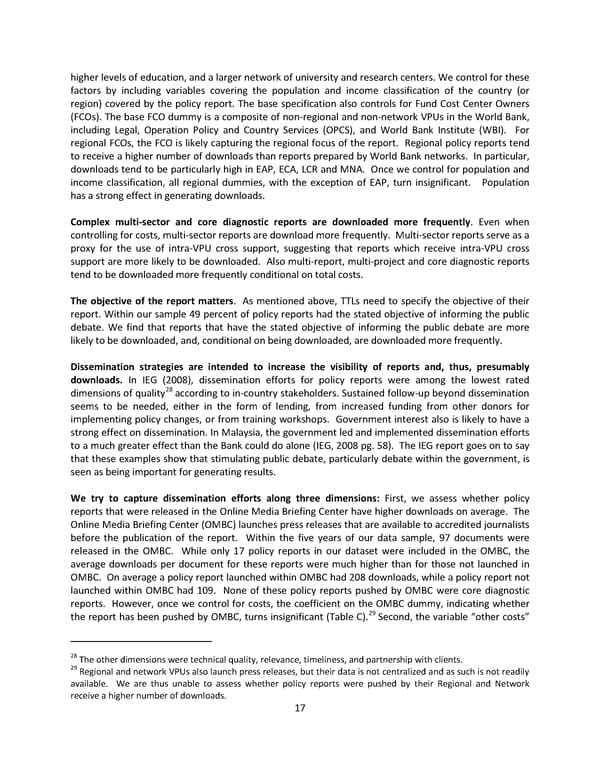higher levels of education, and a larger network of university and research centers. We control for these factors by including variables covering the population and income classification of the country (or region) covered by the policy report. The base specification also controls for Fund Cost Center Owners (FCOs). The base FCO dummy is a composite of non-regional and non-network VPUs in the World Bank, including Legal, Operation Policy and Country Services (OPCS), and World Bank Institute (WBI). For regional FCOs, the FCO is likely capturing the regional focus of the report. Regional policy reports tend to receive a higher number of downloads than reports prepared by World Bank networks. In particular, downloads tend to be particularly high in EAP, ECA, LCR and MNA. Once we control for population and income classification, all regional dummies, with the exception of EAP, turn insignificant. Population has a strong effect in generating downloads. Complex multi-sector and core diagnostic reports are downloaded more frequently. Even when controlling for costs, multi-sector reports are download more frequently. Multi-sector reports serve as a proxy for the use of intra-VPU cross support, suggesting that reports which receive intra-VPU cross support are more likely to be downloaded. Also multi-report, multi-project and core diagnostic reports tend to be downloaded more frequently conditional on total costs. The objective of the report matters. As mentioned above, TTLs need to specify the objective of their report. Within our sample 49 percent of policy reports had the stated objective of informing the public debate. We find that reports that have the stated objective of informing the public debate are more likely to be downloaded, and, conditional on being downloaded, are downloaded more frequently. Dissemination strategies are intended to increase the visibility of reports and, thus, presumably downloads. In IEG (2008), dissemination efforts for policy reports were among the lowest rated dimensions of quality28 according to in-country stakeholders. Sustained follow-up beyond dissemination seems to be needed, either in the form of lending, from increased funding from other donors for implementing policy changes, or from training workshops. Government interest also is likely to have a strong effect on dissemination. In Malaysia, the government led and implemented dissemination efforts to a much greater effect than the Bank could do alone (IEG, 2008 pg. 58). The IEG report goes on to say that these examples show that stimulating public debate, particularly debate within the government, is seen as being important for generating results. We try to capture dissemination efforts along three dimensions: First, we assess whether policy reports that were released in the Online Media Briefing Center have higher downloads on average. The Online Media Briefing Center (OMBC) launches press releases that are available to accredited journalists before the publication of the report. Within the five years of our data sample, 97 documents were released in the OMBC. While only 17 policy reports in our dataset were included in the OMBC, the average downloads per document for these reports were much higher than for those not launched in OMBC. On average a policy report launched within OMBC had 208 downloads, while a policy report not launched within OMBC had 109. None of these policy reports pushed by OMBC were core diagnostic reports. However, once we control for costs, the coefficient on the OMBC dummy, indicating whether the report has been pushed by OMBC, turns insignificant (Table C).29 Second, the variable “other costs” 28 The other dimensions were technical quality, relevance, timeliness, and partnership with clients. 29 Regional and network VPUs also launch press releases, but their data is not centralized and as such is not readily available. We are thus unable to assess whether policy reports were pushed by their Regional and Network receive a higher number of downloads. 17
 Which World Bank Reports Are Widely Read? Page 22 Page 24
Which World Bank Reports Are Widely Read? Page 22 Page 24